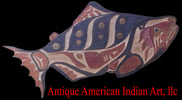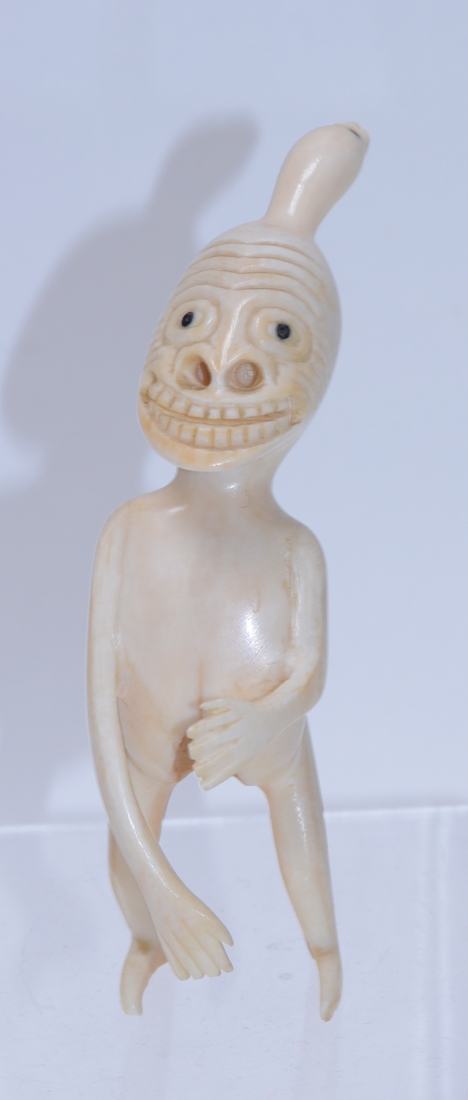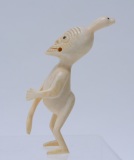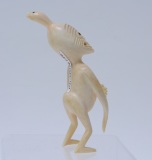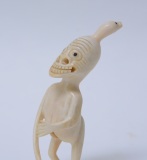- The Artifact Collection Gallery Catalog
- >
- Northwest Coast
- >
- Artifacts / Carvings - Argillite - Horn - Bone - Ivory
- >
- 5060-028 Greenland Tupilak/Billikin Ivory Greenland Tupilak Sculpture, Representing a Shaman's Helper Spirit
5060-028 Greenland Tupilak/Billikin Ivory Greenland Tupilak Sculpture, Representing a Shaman's Helper Spirit
SKU:
5060-028
$1,650.00
$1,650.00
Unavailable
per item
5 1/4"
Caveman-like Tupilak
Some of the same traits in ivory sculpture turn up in Greenland as representing Shamanic spirits called Tupilak. The features include a big toothy mouth, often grinning, pointed head, pug nose and slit eyes; alternatively bulging eyes. These Tupilak were said to represent spirits or objects the Shamans used to destroy their enemies.
Meanings of the same term in various Inuit cultures
Eskimo cultures were far from being alike, although there were some similarities.[12] Similarly to shamanism among Eskimo peoples, also the tupilaq concept had variants. It might be a man-made object, a ghost-like being or a haunting soul. In some cultures it was exactly the shaman who had to deal with it. [a double of...?]
Such distant groups like the Caribou Inuit, Greenland Inuit, Iglulingmiut (Iglulik, Nunavut Inuit) and Copper Inuit knew the concept of tupilaq. But the details differed:
Caribou Inuit
The tupilaq was an invisible ghost. Only the shaman could notice it. It was the soul of a dead person, which became restless because the breach of some death taboo. It scared game away from the vicinity. Thus, the shaman had to help by scaring it away with a knife
Caribou Inuit
The tupilaq was also an invisible being. Like at Iglulik, also the shaman was the only one who could see it. It was a chimera-like creature, with human head and parts from different species of animals. It was dangerous, it might attack the settlement. Then, the shaman had to combat it and devour it with his/her helping spirits
Greenland
The tupilaq was manifested in real, human-made object. It was made by people to the detriment of their enemies. It was a puppet-like thing, but was thought of have magical power onto the victim. It might be made e.g. of mixed parts of dead animals and dead children
Copper Inuit
To the Copper Inuit the tupilaq was similar to the Christian Devil
[At least some of the concepts are identical to the descriptions of the Canadian Wendigoes]
Caveman-like Tupilak
Some of the same traits in ivory sculpture turn up in Greenland as representing Shamanic spirits called Tupilak. The features include a big toothy mouth, often grinning, pointed head, pug nose and slit eyes; alternatively bulging eyes. These Tupilak were said to represent spirits or objects the Shamans used to destroy their enemies.
Meanings of the same term in various Inuit cultures
Eskimo cultures were far from being alike, although there were some similarities.[12] Similarly to shamanism among Eskimo peoples, also the tupilaq concept had variants. It might be a man-made object, a ghost-like being or a haunting soul. In some cultures it was exactly the shaman who had to deal with it. [a double of...?]
Such distant groups like the Caribou Inuit, Greenland Inuit, Iglulingmiut (Iglulik, Nunavut Inuit) and Copper Inuit knew the concept of tupilaq. But the details differed:
Caribou Inuit
The tupilaq was an invisible ghost. Only the shaman could notice it. It was the soul of a dead person, which became restless because the breach of some death taboo. It scared game away from the vicinity. Thus, the shaman had to help by scaring it away with a knife
Caribou Inuit
The tupilaq was also an invisible being. Like at Iglulik, also the shaman was the only one who could see it. It was a chimera-like creature, with human head and parts from different species of animals. It was dangerous, it might attack the settlement. Then, the shaman had to combat it and devour it with his/her helping spirits
Greenland
The tupilaq was manifested in real, human-made object. It was made by people to the detriment of their enemies. It was a puppet-like thing, but was thought of have magical power onto the victim. It might be made e.g. of mixed parts of dead animals and dead children
Copper Inuit
To the Copper Inuit the tupilaq was similar to the Christian Devil
[At least some of the concepts are identical to the descriptions of the Canadian Wendigoes]
1 available
